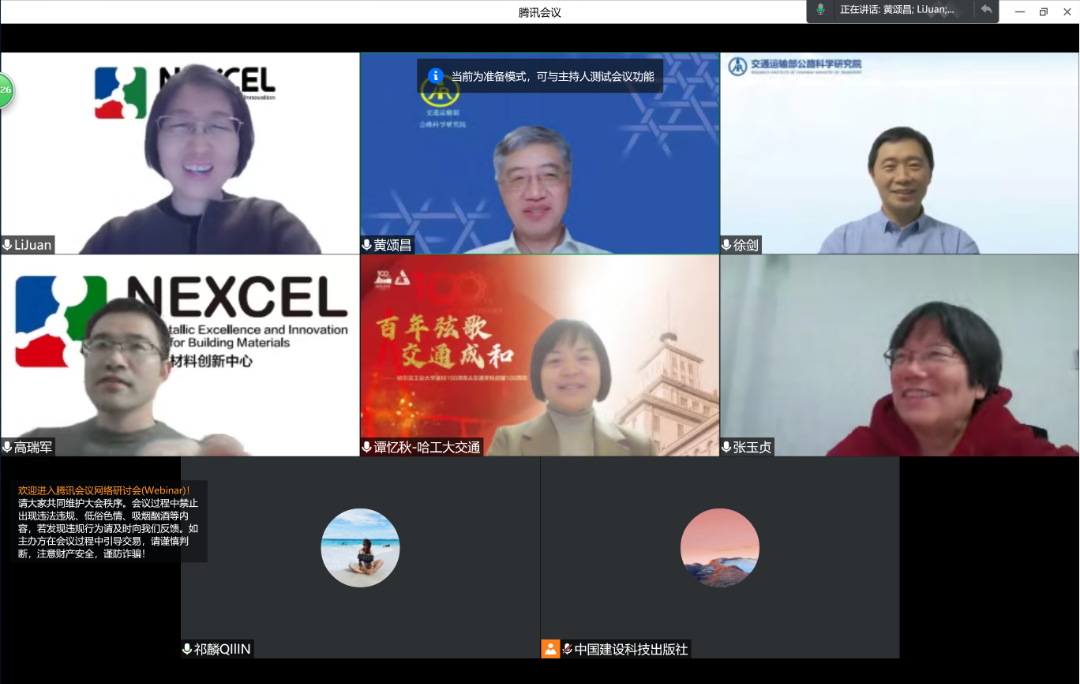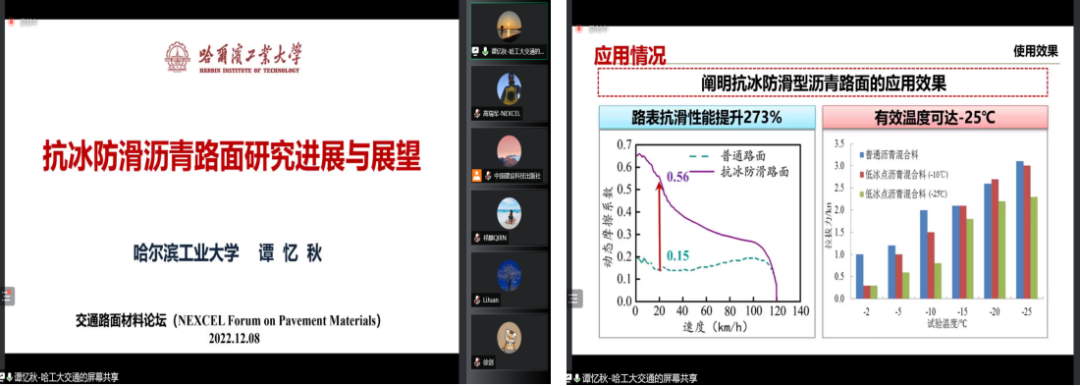
Firstly, Professor ZHANG Yuzhen from China University of Petroleum gave a report on the topic of “Hydrocarbon Based Materials and Derivatives - Asphalt Binder". Professor ZHANG firstly outlined the classification of commonly used non-metallic materials and non-metallic materials for pavements, and explained the application service scenarios of asphalt binders by refining hydrocarbon based materials and derivatives. She pointed out that based on the needs of long-life pavement materials and structures, flexible materials bridge deck pavement, heavy-duty durable materials and structures, etc., it was necessary to strengthen the production, formulation design and application technology research of asphalt, composite modified asphalt, and special emulsified asphalt, to form an integrated design of material structure based on layer function and inter-layer reinforcement, and ultimately to achieve "zero carbon transmission” of every stone, so that each gram of asphalt could serve “60 years".

Professor XU Jian, Researcher of the Research Institute of Highway Ministry of Transport, made a report on the theme of "Theory and Application of Asphalt Pavement Recycling Technology". Professor XU firstly pointed out the necessity and urgency of recycling waste pavement materials for highway construction and maintenance from the perspective of the performance deterioration of the national highways, expressways and asphalt pavements currently in service under load and environment for a long period of time and the need for periodic repair and maintenance. The technical principle and technical category of asphalt pavement recycling technology were mainly introduced. He pointed out that different recycling technologies had their own advantages and disadvantages and different conditions of application, and they were mutually alternative but complementary. There was a need for continuous research to solve the shortcomings at its application end, and a large number of actual engineering practices and the standard specifications based on them were listed. Finally, Professor XU made an outlook on the development of various waste pavement recycling technologies.

Professor TAN Yiqiu of Harbin Institute of Technology shared the results of her team's research on “Research Progress and Prospects of Anti-ice and Anti-skidding Asphalt Pavement" for the phenomenon of snow and ice on pavement and roads in winter, which could seriously affect the efficient, fast and safe operation of roads. Professor TAN introduced in detail the research progress of the project team in recent years from four aspects: asphalt pavement ice and snow state monitoring and early warning, anti-ice and anti-skidding asphalt pavement material development and design, asphalt pavement shallow damage in-situ detection technology, graphene/repair agent micro encapsulated asphalt pavement development, and cited the implementation of China's first active ice and snow melting pavement, the Heilongjiang section of the Da Guang Expressway, China-Russia Heihe Bridge and more than 100 typical engineering applications, with a total paving mileage of more than 5,000 km, providing a boost to the development of anti-ice and anti-skidding asphalt pavement construction in China.

Professor HUANG Songchang from Research Institute of Highway Ministry of Transport shared the theme of "Research and Application of Warm Mix Technology for Asphalt Pavement". Professor HUANG first introduced the development and status of warm mix asphalt technology, through the chemical additive method, organic additives and foam asphalt method of three types of warm mix technology, pointed out that since Year 2000 formally proposed, now become a hot spot for research and promotion of the application of warm mix asphalt technology. Then, Professor HUANG introduced the mechanical foam warm mix asphalt technology in detail, from the foam equipment to the specific material development and construction process. Finally, by citing the world's first modified SMA warm mix test road, Beijing Tongjiu Road, Hebei Hengshui foam warm mix test road, Huai'an section of the Beijing-Shanghai Expressway and other warm mix asphalt and mechanical foam warm mix asphalt engineering applications. Professor HUANG pointed out that warm mix technology was the future direction of development, the inevitability of the green development of energy saving and emission reduction, and the main path for highway traffic to achieve the target of carbon peak.

In the final Salon/ Q&A session, experts interacted with online scholars around issues such as the upstream crude oil source of asphalt, the adaptation of warm mix technology to latitude problems, the advantages, disadvantages and cost performance of asphalt low freezing point materials, the applicable temperature range area of asphalt pavement anti ice materials, the milling and recycling of RAP materials, the applicability and economics of in-situ recycling technology of asphalt pavement in rural roads, etc. The Forum was successfully concluded in a lively academic discussion. In this Forum, domestic scholars further understood the historical development and research status of asphalt pavement, familiar with the different application scenarios of asphalt bonding materials, and broadened the academic horizons.


